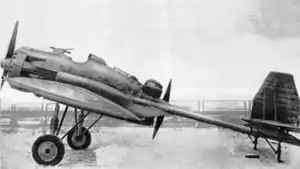Tupolev I-12
The Tupolev I-12 (also known as the ANT-23) was a prototype Soviet fighter aircraft that never reached production. The I-12 was of unconventional design with twin booms made of water pipes containing recoilless rifles and two engines in a push-pull configuration. The aircraft first flew in 1931 but did not enter production due to disappointing performance and operational difficulties such as the inability for the pilot to escape the aircraft without hitting the propeller arc behind him. The second prototype from Tupolev (designated ANT-23bis) was never completed.[1]
| I-12 (ANT-23) | |
|---|---|
 | |
| Role | Fighter |
| National origin | Soviet Union |
| Manufacturer | Tupolev |
| Designer | Viktor Chernyshov |
| First flight | 1931 |
| Status | Retired |
| Number built | One |
Specifications
Data from Shavrov 1985[1]
General characteristics
- Crew: 1
- Length: 9.5 m (31 ft 2 in)
- Wingspan: 15.6 m (51 ft 2 in)
- Wing area: 30 m2 (320 sq ft)
- Airfoil: TsAGI 18%[2]
- Gross weight: 2,400 kg (5,291 lb)
- Powerplant: 2 × Gnome-Rhône 9Ak 9-cylinder air-cooled radial piston engine, 392 kW (526 hp) each
- Propellers: 2-bladed fixed-pitch tractor and pusher propellers
Performance
- Maximum speed: 300 km/h (190 mph, 160 kn)
- Wing loading: 80 kg/m2 (16 lb/sq ft)
- Power/mass: 0.326 kW/kg (0.198 hp/lb)
Armament
- Guns: 2 × 76.2 mm (3 in) APK-4 recoilless rifles
References
- Shavrov V.B. (1985). Istoriia konstruktskii samoletov v SSSR do 1938 g. (3 izd.) (in Russian). Mashinostroenie. ISBN 5-217-03112-3.
- Lednicer, David. "The Incomplete Guide to Airfoil Usage". m-selig.ae.illinois.edu. Retrieved 16 April 2019.
This article is issued from Wikipedia. The text is licensed under Creative Commons - Attribution - Sharealike. Additional terms may apply for the media files.